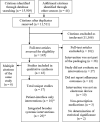Electronic medication packaging devices and medication adherence: a systematic review
- PMID: 25247520
- PMCID: PMC4209732
- DOI: 10.1001/jama.2014.10059
Electronic medication packaging devices and medication adherence: a systematic review
Abstract
Importance: Medication nonadherence, which has been estimated to affect 28% to 31% of US patients with hypertension, hyperlipidemia, and diabetes, may be improved by electronic medication packaging (EMP) devices (adherence-monitoring devices incorporated into the packaging of a prescription medication).
Objectives: To investigate whether EMP devices are associated with improved adherence and to identify and describe common features of EMP devices.
Evidence review: Systematic review of peer-reviewed studies testing the effectiveness of EMP systems in the MEDLINE, EMBASE, PsycINFO, CINAHL, International Pharmaceutical Abstracts, and Sociological Abstracts databases from searches conducted to June 13, 2014, with extraction of associations between the interventions and adherence, as well as other key findings. Each study was assessed for bias using the Cochrane Handbook for Systematic Reviews of Interventions; features of EMP devices and interventions were qualitatively assessed.
Findings: Thirty-seven studies (32 randomized and 5 nonrandomized) including 4326 patients met inclusion criteria (10 patient interface-only "simple" interventions and 29 "complex" interventions integrated into the health care system [2 qualified for both categories]). Overall, the effect estimates for differences in mean adherence ranged from a decrease of 2.9% to an increase of 34.0%, and the those for differences in the proportion of patients defined as adherent ranged from a decrease of 8.0% to an increase of 49.5%. We identified 5 common EMP characteristics: recorded dosing events and stored records of adherence, audiovisual reminders to cue dosing, digital displays, real-time monitoring, and feedback on adherence performance.
Conclusions and relevance: Many varieties of EMP devices exist. However, data supporting their use are limited, with variability in the quality of studies testing EMP devices. Devices integrated into the care delivery system and designed to record dosing events are most frequently associated with improved adherence, compared with other devices. Higher-quality evidence is needed to determine the effect, if any, of these low-cost interventions on medication nonadherence and to identify their most useful components.
Figures




References
Publication types
MeSH terms
Substances
Grants and funding
LinkOut - more resources
Full Text Sources
Other Literature Sources
Miscellaneous

